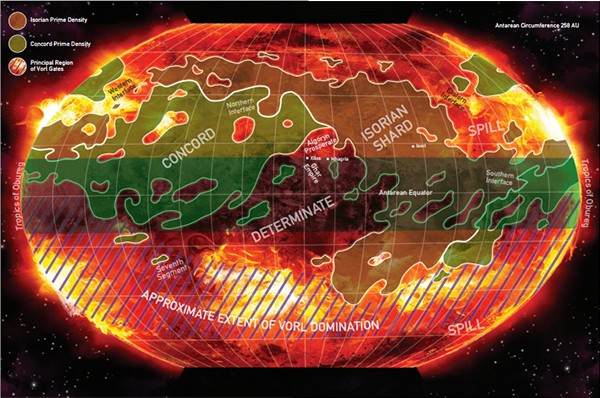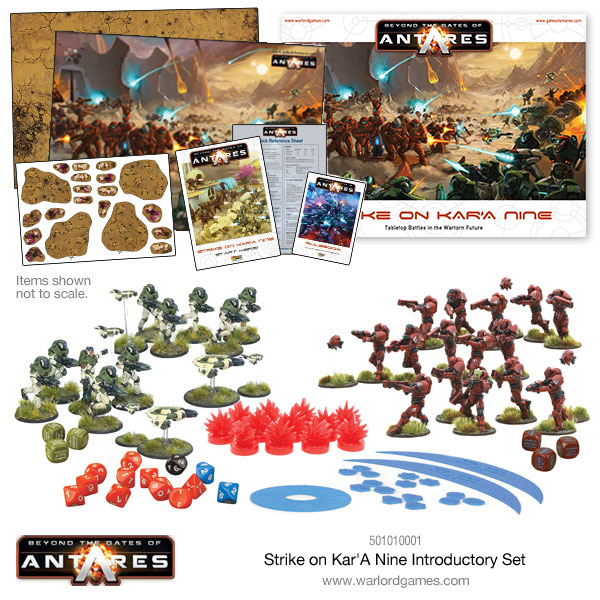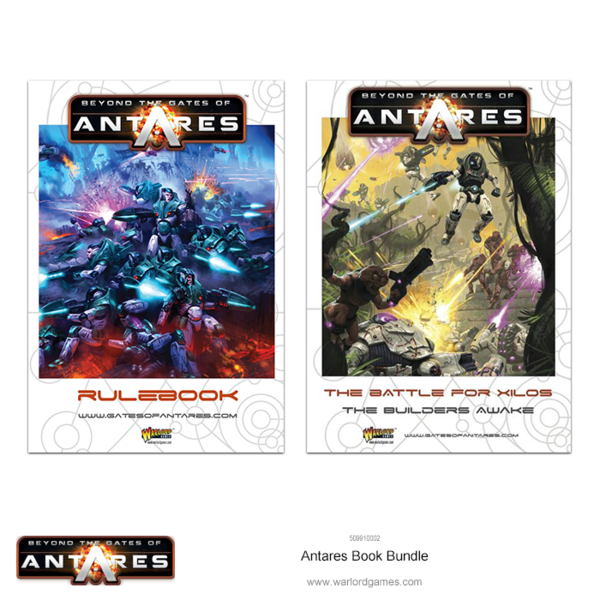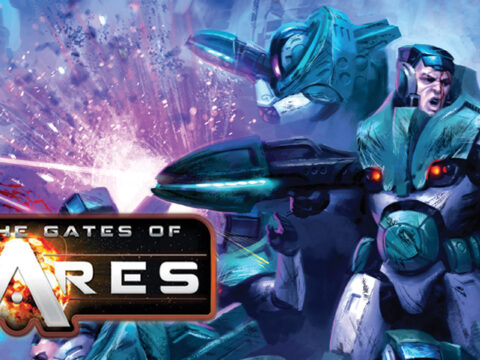Too Many Stars to Count
Interstellar travel in Beyond the Gates of Antares, part III
By Tim Bancroft
In the previous parts of this series of articles, we looked at the first interstellar flight of a young citizen of the PanHuman Concord, Dorun Metarl, and his subsequent career in the PanHuman Concord’s survey shard. Whilst his first taste of star travel aboard the liner The Holiday of a Lifetime took only took nine days to travel 6,700 light years, since then he has traversed more gates and seen more new – and old – star systems than he can count.
This time we’ll be looking at the sort of ships he has encountered on his travels and have a quick glimpse at some of their capabilities. Whilst he will have encountered a huge variety of the Concord’s own ships during his patrols within the boundaries of the Concord’s influence, he has also been close to the Isorian Senatex and the troublesome area known as the Determinate. Here, he has encountered some of the ships mentioned in the upcoming Antares novels.

As far as Dorun can tell, there is no standard design for Concord ships, each system producing them through their nanoconstructors as required for their own needs or whims. The Concord Survey shard is something else: it has a fleet of scout ships, shuttles, maintenance stations and auxiliaries that roughly match the same, core design specifications.
The same holds true for the Concord Combined Command: there are a wide range of core ship designs that helps the IMTel plan its defence and know just what it can expect from each ship class. Beyond that, however, each system has its own twist in terms of design variants, look, feel and specialised capabilities: the variance depends on just how differentiated the shipyard’s shard was from the core C3 nanosphere when the ship was built (nanosphere differences being quickly ironed out once the ship travels to different star systems).
Of course, some factions have distinct design elements. The Algoryn have a tendency for militaristic, angular designs as seen in the vehicles (there is no truly civilian, Algoryn ship) and tend to have larger ships in a given class because of their Ghar-resistant design parameters. The organic feel of the advanced Isorian design is reflected in their own ships which, like the Concord, are also heavily controlled by advanced machine intelligences and artificial minds.
Whilst they normally use Freeborn for travel and cargo services, some Boromite clans possess functional ore carriers and clan ships that have been passed down through generations. Indeed, a Boromite clan ship is constantly upgraded and modified, sometimes considered as much a home to the clan as a Freeborn’s Home Fleet is to them. A few Boromite clans have small, dedicated mercenary transports but, on the whole, it is far more convenient and cost-effective to charter or hitch a ride on a Freeborn vessel to travel to their destination.
The Freeborn, of course, use whatever designs they can trade for, often choosing the most efficient (from their perspective) but modifying them to ensure the final product can take whatever merchandise may turn up. Even within the Senatex and Concord, freeborn ships travel between systems providing everything from mail services to ore carrier and passenger travel. In such roles, an individual Freeborn captain is likely to refurbish an older ship as being a more economically efficient solution – until the maintenance costs mount up, that is. It is worth noting that the Freeborn offer scheduled and chartered inter-system travel far more than any other civilisation, frequently offering space on their own liners and carriers to roving workers such as the Boromites or even to travellers like Dorun.
So whilst there are overall design tendencies and aesthetics for each faction, there are no typical ship designs. The most efficient design, however, is one that matches the shape of the drive field: an oblate spheroid (think of an American football or rugby ball). This means that there are a large number of ships that are wider in the centre and which taper off to sensor masts, thrusters or narrower bodies at the end. But this is not a limiting design factor as the drive field can be flattened to support ships that have a brick-like shape. Further, some ship designs do not bother using all the available space within a drive field as the designers often have more than enough space to ensure that flimsy or easily damaged parts of the ship are left out of the design or are well protected.
So, almost anything goes as far as ship designs go. We can, though, group ships into general classifications and look at what they are capable of in terms of travel – that is, after all, what Dorun is most interested in.
Starship Capabilities
We already know Dorun’s own scoutship is of a general survey class around 120m long (24 yan) and is equipped with an exceptional sensor array as well as a large number of compacted probes. Slightly more capable explorer ships of up to 175m long are sent in to take a closer look at systems that scouts have identified, and their crew is around four strong – though they can take a few more passengers at a pinch. Both the scouts and explorers have gravitic drives capable of around 200G acceleration and can reach SOL 15 within the plane of a system (15% of the speed of light) without having the drive field dangerously penetrated by debris. Again, IMTel prefers to stay well within the safety margins and limit such ships to SOL 10.
There are faster ships in Concord service, however. The C3’s forward interceptor ships can reach acceleration of up to 220G and almost SOL 16 in the plane of ecliptic. The latest design equivalent ships of the Isorian Senatex peak at 240G and around SOL 16.6. Both ship types considerably shorten the time from the gate horizon to an inner-system planet. The equivalent Algoryn ship is larger and more powerful, but tops out at around 145G and SOL 13.
Such speeds are almost meaningless until they are compared with the most common foe: the Ghar. The drives of the Ghar are far less efficient than those of humanity, especially as they do not (cannot) rely on complex machine intelligences to control the fields and drive output. Combat vessels of the Ghar Empire can only support acceleration up to 40G (55G for their fastest scout vessels) and just over SOL zero seven in-system. Ghar transports and auxiliaries are even slower, seldom reaching SOL zero six and incapable of anything above 30G acceleration (which is still three to five times more than it would take to kill a human without some form of GA drive). This means that the ships of the human civilisations could even overtake a Ghar vessel they are pursuing to reach an inner-system planet before the attacking Ghar reach it – providing they can get to the gate within a few hours of the Ghar, that is. Even an old Boromite clan ship or mercenary vessel is almost twice as fast as a Ghar combat vessel!
Even at their slowest, such incredible velocities and accelerations show why combat is normally focused on gate horizons and planets or objects of strategic importance within a star system. Space combat at such velocities is considerably slower, at a maximum of gate transition velocities and often even orders of magnitude slower at SOL decimal zero one (1/10,000 of the speed of light – still incredibly fast). The ‘objects’ on which such combat is focused could be dwarf planets, TORs (Transient Observation Reports) of almost any description, residential orbitals, strange asteroids, or artefacts of alien or Builder origin.
Sample Ships
We’ll move on to a few ships that are used in the fiction to demonstrate their capabilities and size. These range from scout ships of a little over 120m to large liners and home fleet ships tens of kilometres long.
There is a distinctive class of frigates in Concord service that are much-loved by some Freeborn Houses because of their extensive holds and cargo capacity. One of these in Delhren service, the Shamasai Dust of Delhren, is around 300-350m long. Such frigates are closer to the Age of Sail ‘cruiser’ concept with marines, such as vardanari, domari and ferals, as well as a regular crew and cargo hold. This particular frigate has a primary spinal lance as well as plasma- and mag- secondary batteries and X-rails: launchers for a variety of missiles and kinetic spikes. The main problem from a Concord viewpoint, is that the Freeborn’s missile payload is highly variable, such frigates being re-equipped with the Freeborn’s fabled fabricator machines.
There is a rumour about an an Isorian attack drone carrier ship. Though having four machine intelligence cores on board – three in each of its carried combat drones and one in the core carrier, it also has around ten crew. At around 250m long, it looks bulky with all three combat drones onboard as each is around 120m long and capable of carrying a widely varying weapons payload.
We’ve already met the Concord cruise liner The Holiday of a Lifetime, a ship carrying a million or more permanent residents as well as crew and passengers. At approximately 5km long by 1km high and 1.5km wide, it looks a bit like a soft-edged brick with sensors and protrusions all over its body. Freeborn liners might be similar, though would vary in size from 1km upwards depending on how many Freeborn families live permanently onboard and the type of work the ship is expected to undertake – never mind the smaller cargo ships used, perhaps, to transport Boromites, mercenaries or other workers to their new contracts.
The Holiday, though, is nothing like the huge TOR 563. This ancient wreck is rarely seen but drifts through Antarean space, being pulled into systems when it encounters a gate. Its drives have long-ago been disabled by a terribile weapon blast but it is still 20-25km long by about 5km in diameter – a truly gargantuan vessel that just fits into the Antares tunnels.
Such a vessel is dwarfed by the home fleet vessels of the Freeborn vardos. Such ships have some drive capability to keep them in orbit (or to shift their orbit) but can never travel through the Antares nexus, being too big to fit through an Antares gate. The Radiance of Delhren, a diplomatic host vessel, is over 40km long by roughly 10km square, though its surface features make it resemble anything but a simple brick. Within such a ship are not only living quarters for many different factions and alien species, but also manufacturing plants, repair facilities, space docks and trading spaces as well as gardens, parks and sports arenas.
The Radiance is accompanied in its orbit around the star Delhren III by its even larger host ship, the Vard of Delhren, a ship which provides living and work spaces for the vard, the major Delhren domas, extensive manufacturing plants as well as acting as the home for millions of Delhren.
There are even larger ships in and around Antarean space, some being little more than orbitals, whether round a planet or star. Whilst many have artificial gravity, that gravity can be provided by the old-fashioned spin or via low-power gravitic annihilation drives that provide an artificial ‘down’ as well as being able to move the ship or orbital (slowly!) should an emergency crop up.
But what about Ghar vessels? These tend not to vary so widely in size. Two troop transports onto which Shaltok was posted, the Bearer of Triumph over Humanity IX and XIV, are from 500m to 1km long and carry a variety of combat landers and dropships. Another heavy cruiser he encounters, one in the Imposition of Triumph class, is somewhere between 2.5-3km long and packed with Ghar quantum generators, missile batteries and disruptor weaponry.
Final
This is merely the briefest of introduction to starships and spaceships in the Antares universe. The vast expanses of the Concord and Isorian Shard support massive variation of designs.Even the Freeborn houses and Boromite clans vary widely in the type and size of ship they use – the only commonality being that Boromite clanships are designed to travel to their workplace whilst the massive ships of the Freeborn home fleets typically orbit a star. The only faction with anything like a consistent set of designs to its ships is the Algoryn Prosperate, the needs of its military conflict against the Ghar forcing some form of consistency in design.
Even here, though, the need to keep ahead of the Ghar means the Algoryn are constantly looking for new designs, new techniques and new weaponry to give them an edge against their ancient foe.
The ships of Antares are as varied as the millions of gates that make up its universe!
Tim Bancroft runs the Freeborn Shard podcast, is also the first Antares Gate Builder and has just finished a novel based in the universe of Beyond the Gates of Antares (due out 2017).
Follow Tim on his Blog at: timbancroft.me.uk.
Listen to the Freeborn Shard at: soundcloud.com/the-freeborn-shard.
Do you have an article within you? Are you itching to show your collection to the world of Bolt Action? Then drop us a line with a couple of pictures over on our Facebook page or share with all over at the Warlord Forum
Begin your Antarean adventures
Strike On Kar’A Nine is the perfect way to build your forces and learn to Battle in Antares:



